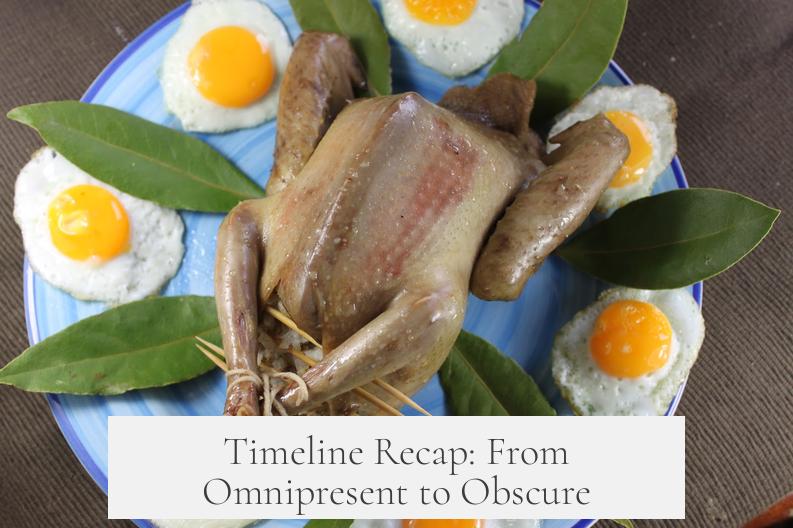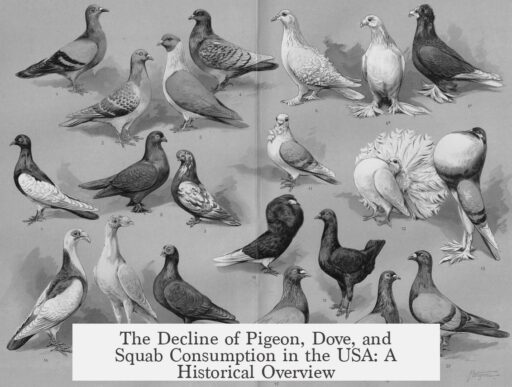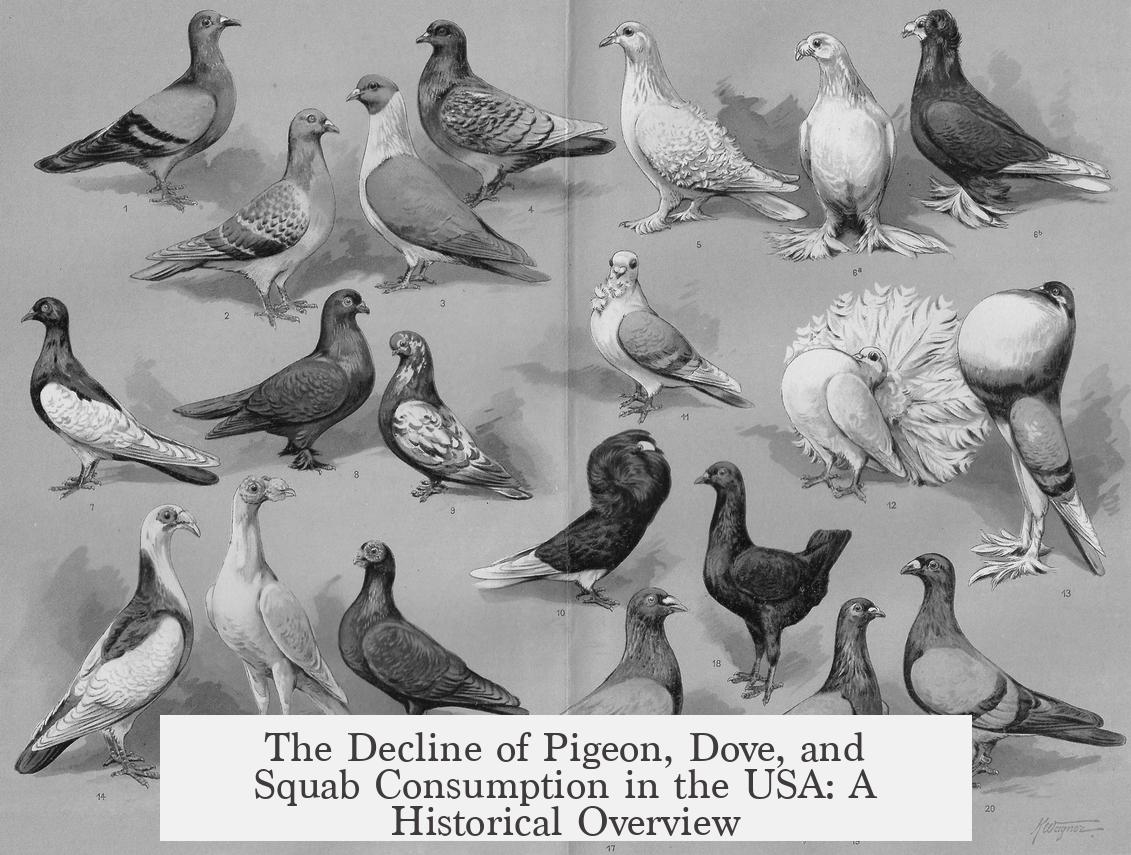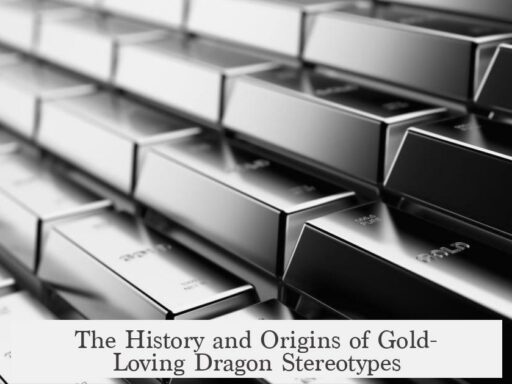Pigeons, doves, and squabs stopped being commonly eaten in the USA primarily by the early to mid-20th century. This shift resulted from the extinction of the passenger pigeon, the depletion of wild pigeon populations, and changes in food culture and farming practices.
In the early 1900s, wild pigeons and doves were abundant and widely hunted or trapped for food. However, the passenger pigeon, once a major source of wild game and a staple for many rural Americans, became extinct by the early 20th century. This extinction greatly reduced the availability of wild pigeons as an accessible food supply. A.W. Schorger’s research in The Passenger Pigeon: Its Natural History and Extinction (1955) highlights how this extinction directly affected pigeon consumption.
Even before the passenger pigeon disappeared, eating squab was not universally common. For example, in the late 19th and early 20th centuries, some individuals—like those born in the 1880s—were known as exceptional squab eaters, suggesting it was already a less frequent dietary choice by then.
After the early 20th century, raising pigeons for meat became more costly and difficult compared to chickens. This economic factor contributed to the decline in squab as a common meat source. Poultry farming’s rise led families to favor chickens, which are easier and cheaper to breed in large quantities.
Today, pigeon and dove meat consumption persists but mainly in specific regions and cultures. In some southern U.S. states, wild dove hunting remains popular. Hunters often plan their seasons well in advance, showing a niche but ongoing cultural tradition. For instance, Georgia’s official wildlife website provides resources and regulations for dove hunting, underlining its localized popularity.
| Period | Key Event | Impact |
|---|---|---|
| Late 19th to Early 20th Century | Passenger pigeon hunting and wild pigeon abundance | Wide pigeon consumption |
| Early 20th Century | Passenger pigeon extinction | Reduced wild pigeon availability |
| Mid 20th Century | Squab consumption declines; more costly to raise pigeons | Shift toward chicken and other meats |
| Present | Regional dove hunting continues | Limited, niche consumption |
- Pigeon and squab consumption decline began in the early 20th century.
- Passenger pigeon extinction drastically reduced wild pigeon meat availability.
- Raising pigeons became less economical than chickens after mid-20th century.
- Wild dove meat is still eaten, mostly in southern U.S. regions today.
When Did Pigeons, Doves, and Squabs Stop Being Commonly Eaten in the USA?

Pigeons, doves, and squabs gradually stopped being commonly eaten in the USA by the early to mid-20th century. Various factors contributed to this decline, including the extinction of the passenger pigeon, rising costs of raising pigeons, and changing cultural preferences. Let’s unpack this story, which combines nature, culture, and economics.
Imagine the skies of 19th-century America. Immense flocks of wild pigeons darkened the sky. They were free for the taking and an accessible source of protein. Hunters and families eagerly feasted on these birds. However, this abundance didn’t last.
The Early 20th Century Decline: When the Flock Flew Away
By the early 1900s, the landscape had changed dramatically. Almost magically, those vast flocks disappeared. The once common passenger pigeon was gone, extinct. This bird was not just any pigeon; it was one of the most hunted and eaten wild birds across North America. Its extinction hit rural communities hard, who had relied on it as a reliable food source.
This extinction wasn’t a mystery. Overhunting and habitat destruction pushed the passenger pigeon to the brink. As a result, the vast free-for-the-taking pigeon meat market collapsed. Hunters and families lost a significant food resource.
As chicken farming surged, raising pigeons became less attractive. It was harder and more expensive to raise pigeons than chickens. While chickens adapted well to large-scale farming and provided affordable meat, pigeons lagged behind. Rising farming costs and fewer wild pigeons combined effectively ended the era when pigeons were a common food staple.
Anecdotes from the Past: Cultural and Generational Shifts
Take my grandfather’s generation as an example. Born in 1885 and living until 1956, he was an avid fan of squab—the young pigeon famous for its tender meat. Yet, even in his lifetime, squab was somewhat rare. People around him would often note how remarkable it was that he enjoyed eating squab so much.
Curiously, none of his children picked up the habit of eating squab. The tradition seemed to end with him. This familial shift mirrors a larger cultural trend toward abandoning pigeons and doves as a regular food source. Preferences for chicken, beef, and pork grew stronger.
Regional Popularity and Niche Hunting Today
So, are pigeons and doves extinct from American plates entirely? Nope, not quite. They still survive, but mostly in niche hunting communities and specific regions.
In southern states like Georgia, dove hunting remains a cherished tradition. Hunters even make reservations a year in advance to secure their spot on opening day. It’s a cultural ritual, a reminder of a bygone era. But it’s definitely not mainstream.
For example, the Georgia wildlife department’s website highlights dove hunting seasons and regulations. This shows that while pigeon meat is far from common in restaurants or homes, it still has a place in American cuisine for a few enthusiasts.
Timeline Recap: From Omnipresent to Obscure

- Up to the early 20th century, common wild pigeons were plentiful and widely eaten.
- The extinction of the passenger pigeon (early to mid-20th century) removed a major accessible source of pigeon meat.
- Squab was somewhat uncommon even in the first half of the 20th century.
- Post-mid-20th century, raising pigeons became more expensive and less common compared to chickens.
- Today, pigeon meat consumption exists mainly in niche regional pockets and specific cultures.
Thinking Beyond the Plate
Why should you care about when pigeons stopped being commonly eaten? Understanding this shift reveals how ecology, economics, and culture collide on your dinner plate.
It also raises questions about sustainability and food traditions. Could more Americans embrace squab as a delicacy now? It’s tender, flavorful, and requires less land than raising cattle. Yet, cultural habits and availability largely dictate what we eat.
So next time you see a pigeon cooing on a city ledge, remember it used to be a dinner guest in American homes—once a symbol of abundance, now a subtle echo of food history and changing times.
Practical Tips If You’re Curious to Try Squab
- Find specialty farms or gourmet markets that sell squab. It’s a delicacy, so expect a premium price.
- Try regional cooking styles. Southern hunters often grill or roast doves with simple seasonings to highlight the meat’s flavor.
- If you hunt, check local regulations and seasons. Hunting doves remains legal and popular in many states.
Who knows? Maybe you’ll join the growing group rediscovering a unique and historic American food.
Conclusion
The decline of pigeons, doves, and squabs as common food sources in the USA ties closely to environmental loss, economic changes, and shifting cultural tastes.
By the early 20th century, free-range wild pigeons vanished, the passenger pigeon went extinct, and raising pigeons turned expensive compared to chickens. This triple whammy nudged Americans away from squab as everyday fare. Today, pigeon and dove meat linger on menus and in hunting traditions but no longer grace tables nationwide like they once did.
So the next time you wonder about forgotten foods, pigeons offer a story that’s part environmental tragedy, part cultural evolution, and part culinary curiosity.
When did pigeons stop being a common food source in the USA?
Pigeons stopped being commonly eaten by the early 20th century. The extinction of wild passenger pigeons and the decline of wild flocks made them scarce and harder to access.
Did the extinction of the passenger pigeon affect pigeon consumption?
Yes. The passenger pigeon was once a widely hunted food bird. Its extinction removed a major, accessible source of pigeon meat, reducing its availability for rural Americans.
Was squab commonly eaten in the 20th century?
Squab was never very common even in the early 20th century. Personal accounts suggest it was a specialty dish rather than an everyday meal during that time.
Why did pigeon consumption decline compared to chicken?
Raising pigeons became more difficult and costly than raising chickens. This economic factor contributed to pigeons falling out of favor as a common food source by mid-20th century.
Is pigeon or dove meat still eaten today in the USA?
Yes, but only in limited regions and cultures, especially in the South. Wild dove hunting remains popular in some areas, but overall consumption is no longer widespread.



